| October 15, 2008 |  |
MarsDaily Advertising Kit |
| Previous Issues | Oct 14 | Oct 13 | Oct 12 | Oct 10 | Oct 09 |
Opportunity Takes A Victory Lap Pasadena CA (SPX) Oct 14, 2008
Pasadena CA (SPX) Oct 14, 2008A journey of 7.5 miles began with a partial victory lap around "Victoria Crater," as Opportunity headed south toward enormous "Endeavour Crater." Partway around the circuit, Opportunity passed the 7.5-mile mark of the mission. In metric terms, the rover began a 12,000-meter, cross-country trek by ending a similar 12,000-meter journey across uncharted terrain and in and out of craters. ... more The Sun Is Setting On Phoenix  Moffett Field CA (SPX) Oct 14, 2008
Moffett Field CA (SPX) Oct 14, 2008As fall approaches Mars' northern plains, NASA's Phoenix Lander continues to dig into the red planet's soil and deliver samples to its onboard science instruments for analysis. Over the past two weeks, Phoenix's nearly 2.4-meter-long (8 foot) arm moved a rock named "Headless" about 0.4 meters (16 inches) and snapped an image of the rock with its camera. Then the robotic arm scraped the ... more India Not Engaged In Space Race With China  Bangalore, India (PTI) Oct 13, 2008
Bangalore, India (PTI) Oct 13, 2008As India prepares for its first unmanned mission to the Moon next week, ISRO chief Madhavan Nair has said that New Delhi is not engaged in a space race with Beijing, stating that the priorities of the two countries are different and there is no competition. Chandrayaan-1, the country's first unmanned lunar venture, is slated for launch on October 22 and India has proposed Mars mission in ... more NASA Supercomputer Shows How Dust Rings Point To Exo-Earths  Greenbelt MD (SPX) Oct 13, 2008
Greenbelt MD (SPX) Oct 13, 2008Supercomputer simulations of dusty disks around sunlike stars show that planets nearly as small as Mars can create patterns that future telescopes may be able to detect. The research points to a new avenue in the search for habitable planets. "It may be a while before we can directly image earthlike planets around other stars but, before then, we'll be able to detect the ornate and ... more What Will Flight To Mars Reveal  Moscow (RIA Novosti) Oct 13, 2008
Moscow (RIA Novosti) Oct 13, 2008Deep space exploration is becoming an ever bigger part of national space programs. Currently, missions to the Moon and Mars are considered feasible. The U.S. has announced preparation for another space probe launch to collect data from the Martian atmosphere, scheduled for 2013. In Russia, Martian exploration is confined to ground tests so far. The project Mars-500, aimed at determining ... more |
mars-general
 mars-odyssey  mars-lab 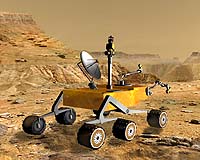 |
 Pasadena CA (SPX) Oct 10, 2008
Pasadena CA (SPX) Oct 10, 2008As fall approaches Mars' northern plains, NASA's Phoenix Lander is busy digging into the Red Planet's soil and scooping it into its onboard science laboratories for analysis. Over the past two weeks, Phoenix's nearly 2.4-meter-long (8 feet) arm moved a rock, nicknamed "Headless," about 0.4 meters (16 inches), and snapped an image of the rock with its camera. Then, the robotic arm ... more An Opportunity For A Tour Will Be An Endeavour  Pasadena CA Oct 04, 2008
Pasadena CA Oct 04, 2008Opportunity has embarked on the next great challenge -- a journey of 12 kilometers (7.5 miles) southeast to a huge hole in the ground nicknamed "Endeavour Crater." Measuring 22 kilometers (14 miles) from rim to rim and plunging 300 meters (1,000 feet) below the surface, Endeavour Crater is significantly larger than "Victoria Crater," which is 730 meters (almost half a mile) wide and 70 meters (2 ... more Nicaraguan Volcano Provides Insight Into Early Mars  Moffett Field CA (SPX) Oct 01, 2008
Moffett Field CA (SPX) Oct 01, 2008Volcanic eruptions were commonplace on ancient Mars, when vents and fissures spewed out gases like water vapor, carbon dioxide, sulfur dioxide, and hydrogen sulfide. Such locales were very hot and very acidic - characteristics that would seem to be inhospitable to life. But in recent years researchers have discovered a vast array of primitive organisms living in analogous environments on Earth. ... more Mars Lander Sees Falling Snow, Soil Data Suggest Liquid Past  Pasadena CA (SPX) Sep 30, 2008
Pasadena CA (SPX) Sep 30, 2008NASA's Phoenix Mars Lander has detected snow falling from Martian clouds. Spacecraft soil experiments also have provided evidence of past interaction between minerals and liquid water, processes that occur on Earth. A laser instrument designed to gather knowledge of how the atmosphere and surface interact on Mars has detected snow from clouds about 4 kilometers (2. 5 miles) above the ... more |
mars-water-science
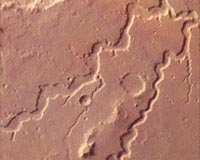 mars-mers 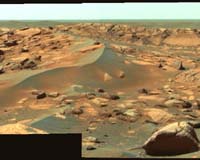 mars-mers 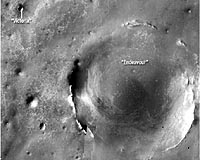 |
 Pasadena CA (JPL) Sep 29, 2008
Pasadena CA (JPL) Sep 29, 2008NASA's Mars Reconnaissance Orbiter has revealed hundreds of small fractures exposed on the Martian surface that billions of years ago directed flows of water through underground Martian sandstone. Researchers used images from the spacecraft's High Resolution Imaging Science Experiment, or HiRISE, camera. Images of layered rock deposits at equatorial Martian sites show the clusters of ... more Reaching for the stars: a space travel timeline  Washington (AFP) Sept 25, 2008
Washington (AFP) Sept 25, 2008Milestones in the history of manned space flight: -- 1st century AD: A simple explosive substance appears in China. To create a festive effect, containers filled with it are believed to have been thrown onto fires, whereupon they sometimes flew up into the air. -- 1232: The first documented use of "fire-sticks" as weapons -- by Chinese forces repelling a Mongol invasion. ... more Space key to mankind's survival: NASA chief  Washington (AFP) Sept 25, 2008
Washington (AFP) Sept 25, 2008Mankind's very survival depends on the future exploration of space, said NASA chief Michael Griffin in an interview with AFP marking the 50th anniversary of the US space agency. This journey, said the veteran physicist and aerospace engineer, is full of unknowns and has only just begun. "Does the survival of human kind depend upon it? I think so," he said. Griffin compared the first ... more Meteorite experiment deals blow to 'bugs from space' theory  Paris (AFP) Sept 25, 2008
Paris (AFP) Sept 25, 2008A novel experiment has dealt a setback to a theory that life on Earth was kickstarted by bacteria that hitched a ride on space rocks. The "pan-spermia" hypothesis is that cells were transported to the infant Earth on rocks that were bumped off other planets or even came from another star system. The theory gained a boost in 1996 when a group of US scientists proposed that a famous meteor ... more
|
nasa
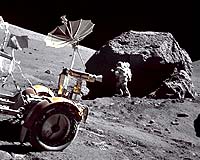 nasa 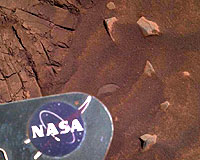 dragonspace  |
| Previous Issues | Oct 14 | Oct 13 | Oct 12 | Oct 10 | Oct 09 |
| The contents herein, unless otherwise known to be public domain, are Copyright 1995-2007 - SpaceDaily. AFP and UPI Wire Stories are copyright Agence France-Presse and United Press International. ESA Portal Reports are copyright European Space Agency. All NASA sourced material is public domain. Additional copyrights may apply in whole or part to other bona fide parties. Advertising does not imply endorsement, agreement or approval of any opinions, statements or information provided by SpaceDaily on any web page published or hosted by SpaceDaily. Privacy statement |